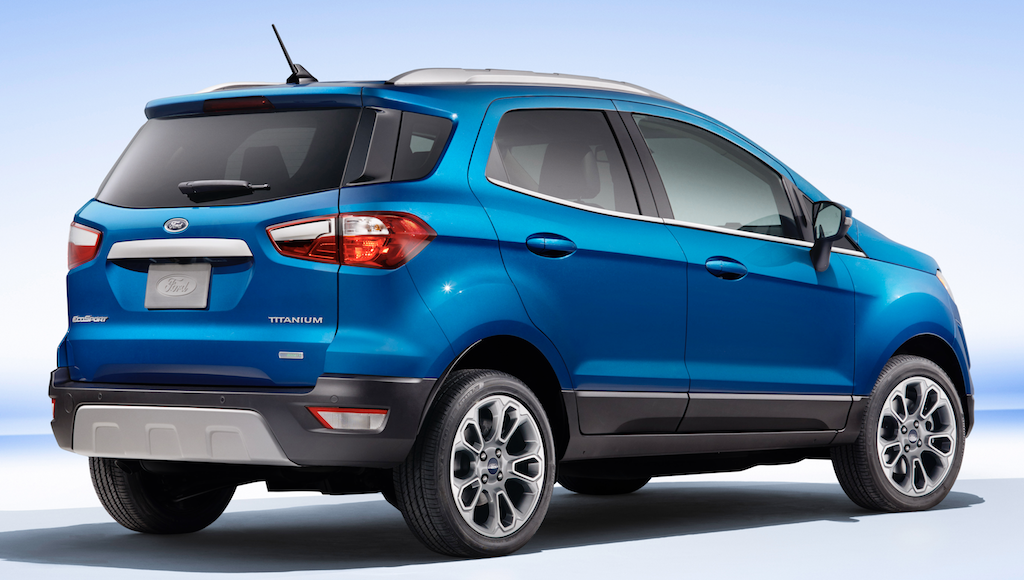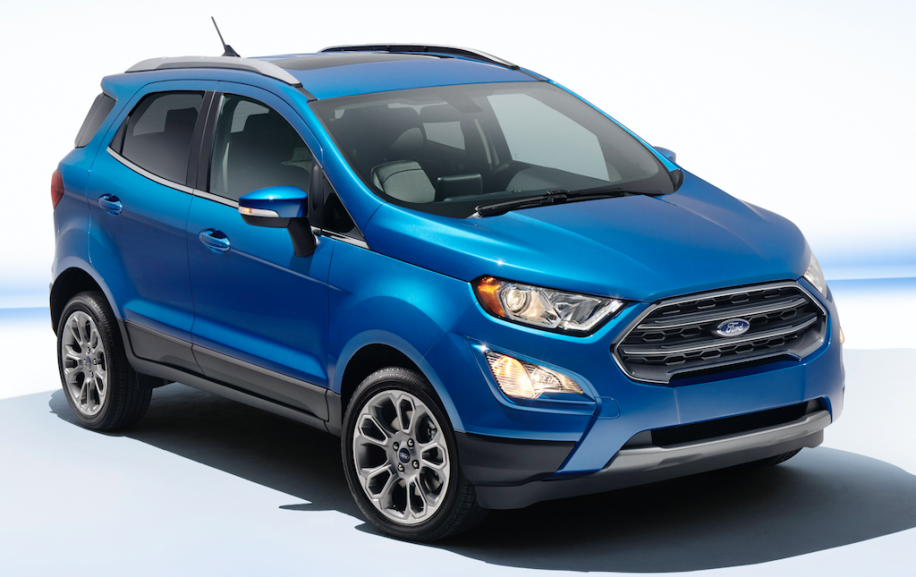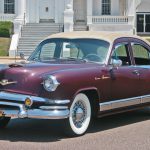
 2018 Ford EcoSport Titanium AWD
2018 Ford EcoSport Titanium AWD
Class: Subcompact Crossover
Miles driven: 532
Fuel used: 21.4 gallons
Real-world fuel economy: 24.9 mpg
Driving mix: 30% city, 70% highway
EPA-estimated fuel economy: 23/29/25 (city, highway, combined)
| CG Report Card | |
|---|---|
| Room and Comfort | C- |
| Power and Performance | C- |
| Fit and Finish | B- |
| Fuel Economy | C |
| Value | C+ |
| Report-card grades are derived from a consensus of test-driver evaluations. All grades are versus other vehicles in the same class. Value grade is for specific trim level evaluated, and may not reflect Consumer Guide's impressions of the entire model lineup. | |
| Big & Tall Comfort | |
| Big Guy | C- |
| Tall Guy | B |
| Big & Tall comfort ratings are for front seats only. "Big" rating based on male tester weighing approximately 350 pounds, "Tall" rating based on 6'6"-tall male tester. | |
Fuel type: Regular gas
Base price: $27,330 (not including $995 destination charge)
Options on test vehicle: Cold Weather Package ($450), 17-inch premium painted wheels ($470)
Price as tested: $29,245 (note that incentives totaling up to $2750 are available in some areas)
Quick Hits
The great: Compact dimensions, comfortable seating position
The good: Cargo flexibility, control layout
The not so good: Disappointing fuel economy, rear-seat legroom, lacking some commonly available safety features
More EcoSport price and availability information
CG Says:
In what may well be one of the best automotive upgrades of 2018, the all-wheel-drive version of the Ford EcoSport Titanium comes with a 2.0-liter engine in place of the 1.0-liter turbocharged engine in the front-wheel drive EcoSport Titanium — all for just $1450 extra. And besides the advantages of AWD, at least as important was the extra power of the larger engine.

That latter point really showed itself both on the road and in our timed 0-60 runs. Whereas the little turbo often felt overtaxed — even in around-town driving but particularly at higher speeds — and averaged 0-60 mph in a timid 10.2 seconds, this version with the 2.0-liter felt stronger under all circumstances and managed to sprint to 60 in 9.5 seconds. OK, a 7/10ths of a second improvement may not sound like much and “sprint” might be overstating it — that’s still on the slow side of average for the subcompact-crossover class — but it felt quicker enough that acceleration was no longer a significant demerit. And the 6-speed automatic — which some folks prefer to the CVT automatics offered by many rivals — kicked down fairly quickly when the throttle was stabbed at speed. Furthermore, we recorded 24.9 mpg in 70 percent highway driving, exactly what we got with the 1.0-liter in 55 percent highway driving. However, note that neither figure is particularly good for the class — we’ve averaged about 27 mpg with a Chevrolet Trax, Honda HR-V, Hyundai Kona, and Mazda CX-3.
We invite you to read our previous review of the 1.0-liter, front-drive Titanium for more details on how that version of the top-line trim level fared, but some things noticed in this test are worth another mention.
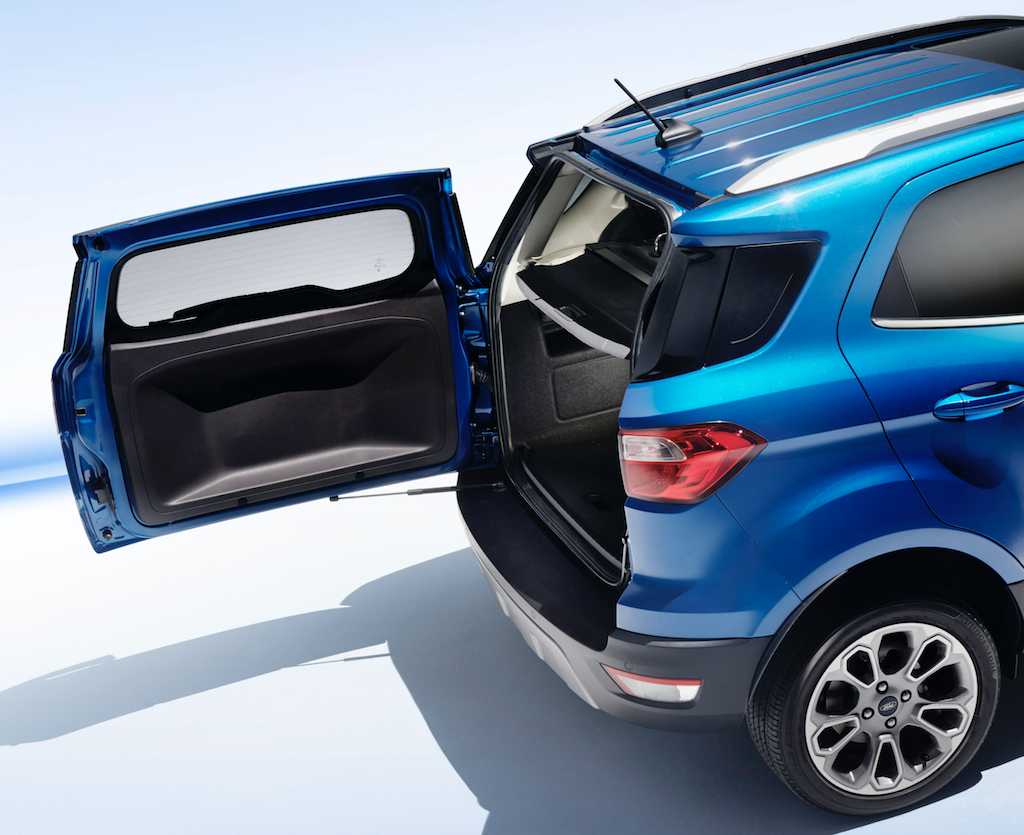
A great gag with the EcoSport is asking a friend to get something out of the cargo area — and then stand and watch while they fumble around trying to find the release button under the center of the liftgate … because it’s not there. Instead, it’s located near the right-side taillight lens, as the “liftgate” is actually a door that opens to the left. Great fun.
Get the door open and you’ll find a clever touch a few other vehicles have, but not nearly enough of them. The floor is a panel that can be removed and set in three different positions: low for maximum cargo height, medium to level the floor with the door opening, and raised to lift the forward edge so that it rests level with the folded rear seat backs, which otherwise leave a 4-inch “step.”
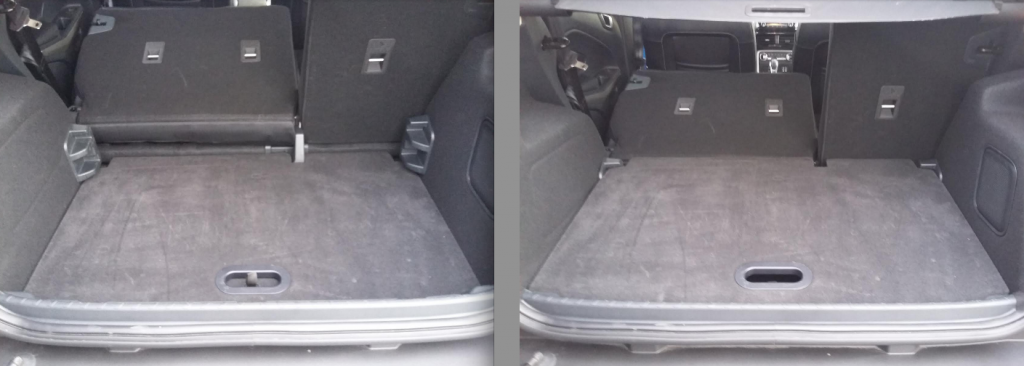
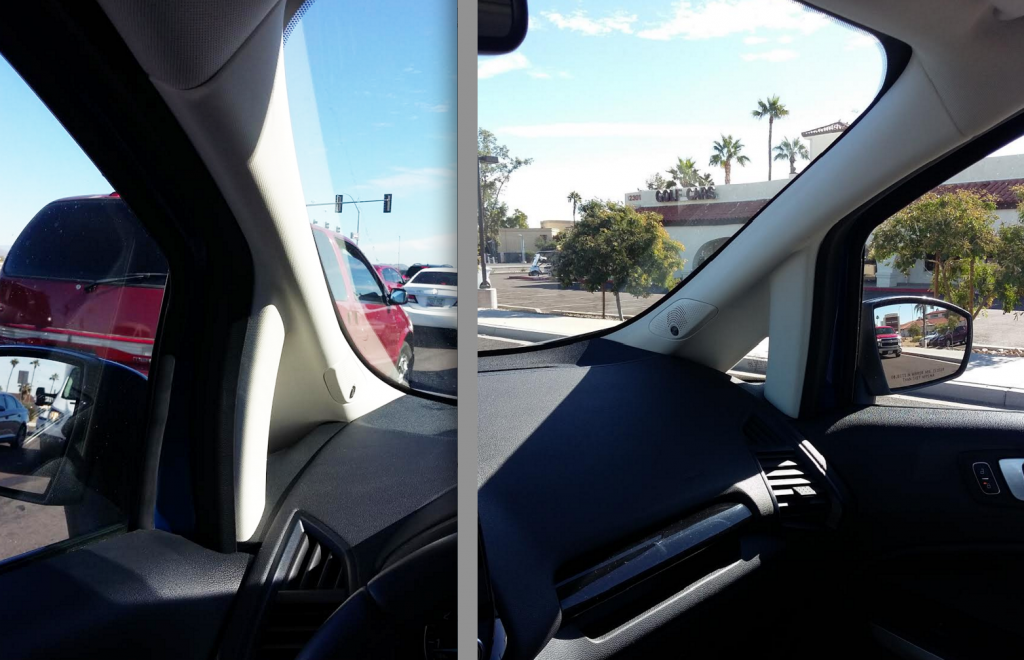
Although visibility is restricted to the front corners due to wide, inverted Y-shaped roof pillars, the right-side one has a little quarter window that allows a view of, for instance, the curb when turning a corner. Visibility is just fair to the sides and rear, though a standard rearview camera helps when backing. Unfortunately, the sun visor doesn’t extend when swung to the side, leaving five inches of the window uncovered.
Audio and climate controls are relatively easy to decipher, but while the former are high and within easy reach, the latter are mounted a bit low. However, they earn points with rotary dials for temperature and fan speed, with mode set by three buttons (defrost, dash vent, and floor vent), all of which can be chosen at the same time — a nice touch. Right below them are handy buttons for the heated front seats and steering wheel, and below that, a button to turn off the engine auto stop/start system — useful in stop and go traffic. Next to it are two lighted USB ports, conveniently located above a slot perfectly sized to hold a cell phone, which is right next to a 12-volt plug. So overall, the control layout earns some kudos.
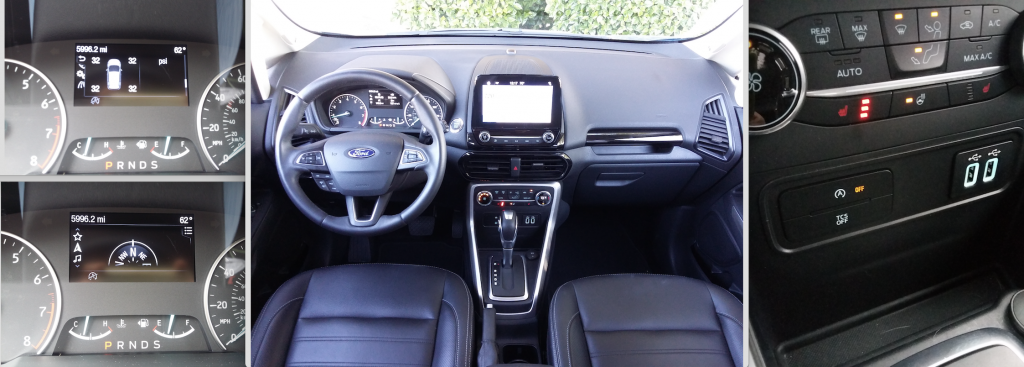
Interior storage space, however, does not. Aside from the convenient cell-phone pouch mentioned, all other storage spaces are small. Interior materials are just so-so, as the dash top and armrests are padded, but not the door tops.
Test Drive: 2018.5 Nissan Rogue Sport SL
For such a small vehicle, the EcoSport offers decent interior space. Front-seaters should find plenty of headroom and legroom. Oddly, the driver seat on our test vehicle had power height adjustment and seat-back angle, but manual fore/aft adjustment. It also had manual lumbar adjustment, a comfort plus. Rear-seat passengers sit on a high cushion that limits headroom for anyone over about 5’11”, though legroom is OK unless the seat ahead is moved far back, and egress is just a bit restricted due to a smallish door opening. A nice feature is the 110-volt AC (household current) outlet on the back of the console.
Although our top-line Titanium included a host of features, one expected safety feature was absent. We’re real fans of forward collision warning and mitigation (and so are most safety groups), but the EcoSport doesn’t offer it. It does, however, offer blind-spot and rear-cross-traffic alert, both of which are standard on the Titanium. Other notable standard features include a moonroof, automatic temperature control, leather-trimmed seats, heated front seats, premium audio system with satellite radio, 8-inch touchscreen, keyless access and starting, and a voice-activated navigation system.
EcoSport is now the shortest crossover you can buy, a selling point to those who may have to park it on a city street. But aside from the lack of forward collision warning, it merits consideration by anyone looking for an inexpensive small crossover — at least when equipped with the bargain-priced 2.0-liter engine.
